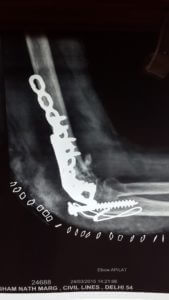Elbow Trauma
Elbow Trauma
Elbow trauma & fractures are difficult fractures to manage as they frequently lead to post-traumatic stiffness. The key is to fix them accurately & stabilize them adequately so that they can be mobilized early.
Similarly radial head & neck fractures also requires meticulous fixation to get good results. Sometimes these fractures may need replacement if the fracture is too comminuted.




FAQs related to Elbow Trauma
What is elbow trauma?
Elbow trauma refers to injuries or damage to the elbow joint, which connects the upper arm bone to the forearm bones. It is responsible for forearm movement and various activities. Causes include falls, blows, repetitive motions, or sports accidents. Common injuries include fractures, dislocations, ligament tears, tendonitis, and nerve damage. Symptoms include pain, swelling, stiffness, limited range of motion, and difficulty in daily tasks. Diagnosis and treatment are crucial for recovery. Orthopedic surgeons or sports medicine specialists may use imaging tests like X-rays or MRI scans. Treatment options include rest, immobilization, physical therapy, pain management, or surgery for severe cases. Prompt medical attention is important to prevent complications and promote healing.
How do I know if my elbow injury is serious?
Elbow injuries can result from sports, accidents, or repetitive motions. Identifying the severity of your injury is important for determining the right course of action. Signs of a serious elbow injury include intense pain, swelling, bruising, immobility, or a deformed appearance. However, not all serious injuries exhibit these obvious symptoms. Some injuries like ligament tears or stress fractures may lack immediate pain or visible signs. Seeking medical attention is crucial in such cases to obtain an accurate diagnosis and prevent further harm. Healthcare professionals can conduct a thorough examination, order imaging tests, and recommend appropriate treatments such as rest, physical therapy, or surgery for severe cases. Remember, early intervention and accurate diagnosis are vital for a successful recovery from an elbow injury.
How do you treat elbow trauma?
Elbow trauma refers to damage or injury to the elbow joint caused by falls, sports injuries, or accidents. Treatment depends on the severity of the injury. Mild cases can be managed with rest, ice, compression, and elevation (RICE) along with over-the-counter pain medications. Severe cases may require immobilization with a splint or cast and physical therapy exercises. Surgery may be necessary to repair ligaments, tendons, or bones. Recovery time varies based on the injury and treatment. Follow healthcare professional guidance for proper healing and to prevent complications.
What are 3 common injuries of the elbow?
The elbow is prone to injuries due to its frequent use and vulnerability to repetitive stress. Common injuries include tennis elbow, golfer’s elbow, and elbow dislocation. Tennis elbow, or lateral epicondylitis, causes inflammation and pain on the outside of the elbow due to repetitive wrist and forearm motions. Golfer’s elbow, or medial epicondylitis, affects the inner side of the elbow and is caused by overuse or strain of the forearm muscles and tendons. Elbow dislocation occurs when the forearm bones are forced out of their normal position at the elbow joint, often due to a fall, direct impact, or twisting motion. Seek medical attention for persistent pain, swelling, or difficulty moving the elbow to ensure proper diagnosis and treatment for a full recovery.
